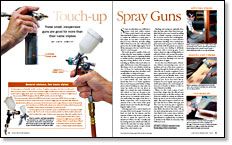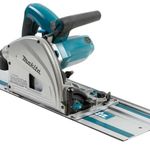Touch-up Spray Guns
These small, inexpensive guns are good for more than their name implies
Synopsis: Jeff Jewitt admits a penchant for spray guns, and of all the ones in his shop, he prefers the touch-up gun the most. He uses them for applying finishes to smaller projects, spraying stains, shading and toning finishes, as well as touch-up jobs. In his article, he shares how to choose a touch-up gun and how to use it in all the ways he does.
Some woodworkers are addicted to power tools and collect routers. Others prefer hand tools and may have hundreds of planes or chisels. I have to confess an addiction to spray guns—I love them. At one time I counted more than 15 in my collection, and after selling half of them last year, the collection has grown into the double digits again. Out of all my spray guns, the one I reach for most often is a touch-up gun.
The touch-up gun is capable of jobs other than what the name implies. I routinely use these little gems for applying finishes to smaller projects, spraying stains, shading and toning finishes and, of course, touching up finishes that need minor repairs. And because some of these guns are dirt cheap, I don’t care whether I muck up one of them by inadvertently leaving something in the gun that I shouldn’t, such as milk paint or catalyzed lacquer.
I often apply stains in more than one layer. My favorite first (or ground) stain color is a water-soluble dye stain. And I’ve found that there is no better applicator than a touch-up gun, particularly on large pieces where brushing on a dye stain can cause lap marks (see the top photo at right). For a simple dye stain, atomization isn’t critical, so I just use the gun to wet down the wood with a dye and then blot up the excess. For intricate inside areas, I can easily adjust the angle of the fan so I hit the corners first. I also cut back on the amount of air, so the vortex of the spray pattern doesn’t prevent the dye from getting into tight corners.
Coloring sapwood to match heartwood is a snap with a touch-up gun. You can cut back on both the fan pattern and the amount of fluid to lay down a subtle line of color to match the sapwood to the heartwood. When I do this, I usually start by wetting down the whole area with solvent for the stain that I’m using—alcohol, water or mineral spirits—to get a better idea of the color I need to use.
From Fine Woodworking #154
For the full article, download the PDF below:
Fine Woodworking Recommended Products

Milwaukee M12 23-Gauge Cordless Pin Nailer

Makita SP6000J1 Track Saw

Diablo ‘SandNet’ Sanding Discs























Log in or create an account to post a comment.
Sign up Log in